Destination Filters
Destination Filters let you prevent certain data from flowing into a destination.
Using Destination Filters, you can conditionally filter out event properties, traits, and fields, or even filter out the event itself.
Common use cases for Destination Filters include the following:
- Managing PII (personally identifiable information) by blocking fields from reaching certain destinations
- Controlling event volume by sampling or dropping unnecessary events for specific destinations
- Increasing data relevance in your destinations by removing unused or unwanted data
- Preventing test or internally-generated events from reaching your production tools
Note: Destination Filters are available to Business Tier customers only.
Destination Filtering Limitations
Keep the following limitations in mind when you use Destination Filters:
- Destination Filters can only be applied to cloud-mode (server-side) streaming destinations. Device-mode destinations aren’t supported.
- You can’t apply Destination Filters to Warehouses or S3 destinations.
- Each filter can only apply to one source-destination pair.
Contact Segment if these limitations impact your use case.
Create a Destination Filter
To create a Destination Filter, follow these steps:
- Go to Connections > Destinations and select your destination.
- Click on the Filters tab of your destination.
- Click + New Filter.
- Configure the rules for your filter.
- (Optional) Click Load Sample Event to see if the event passes through your filter.
- Click Next Step.
- Name your filter and click the toggle to enable it.
- Click Save.
Destination Filters API
The Destination Filters API provides more power than the Segment dashboard’s Destination Filters settings. With the API, You can create complex filters that are conditionally applied using Segment’s Filter Query Language (FQL).
The Destination Filters API offers four different filter types:
| Filter | Details |
|---|---|
drop_event |
Don’t send matched events to the destination. |
sample_event |
Send only a percentage of events through to the destination. |
whitelist_fields |
Only send whitelisted properties to the destination. |
blocklist_fields |
Don’t send blocklisted properties to the destination. |
To learn more, read Segment’s Destination Filters API docs.
Examples
The following examples illustrate common Destinations Filters use cases.
PII Management
Example: Remove email addresses from context and properties:
Property-level allowlisting is available with Segment’s API. Using Destination Filters, you can configure a rule that removes email addresses from context and properties. As a result, Segment only sends traits without PII to the destination.

Control Event Volume
This example shows a filter that controls event volume by only sending User Signed Up and Demo Requested events.
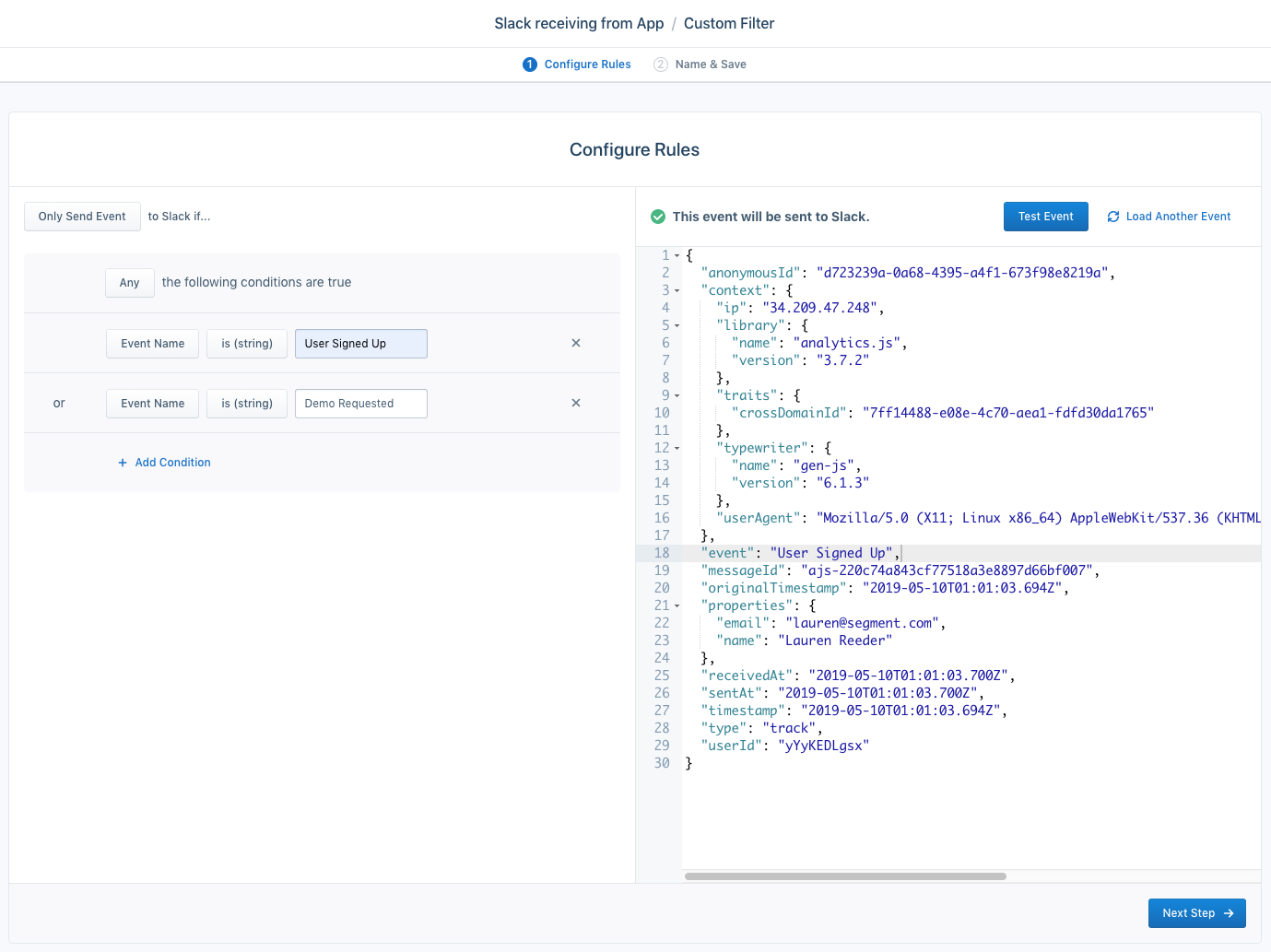
Cleaner Data
This example shows a rule that only sends track calls to Google Analytics.
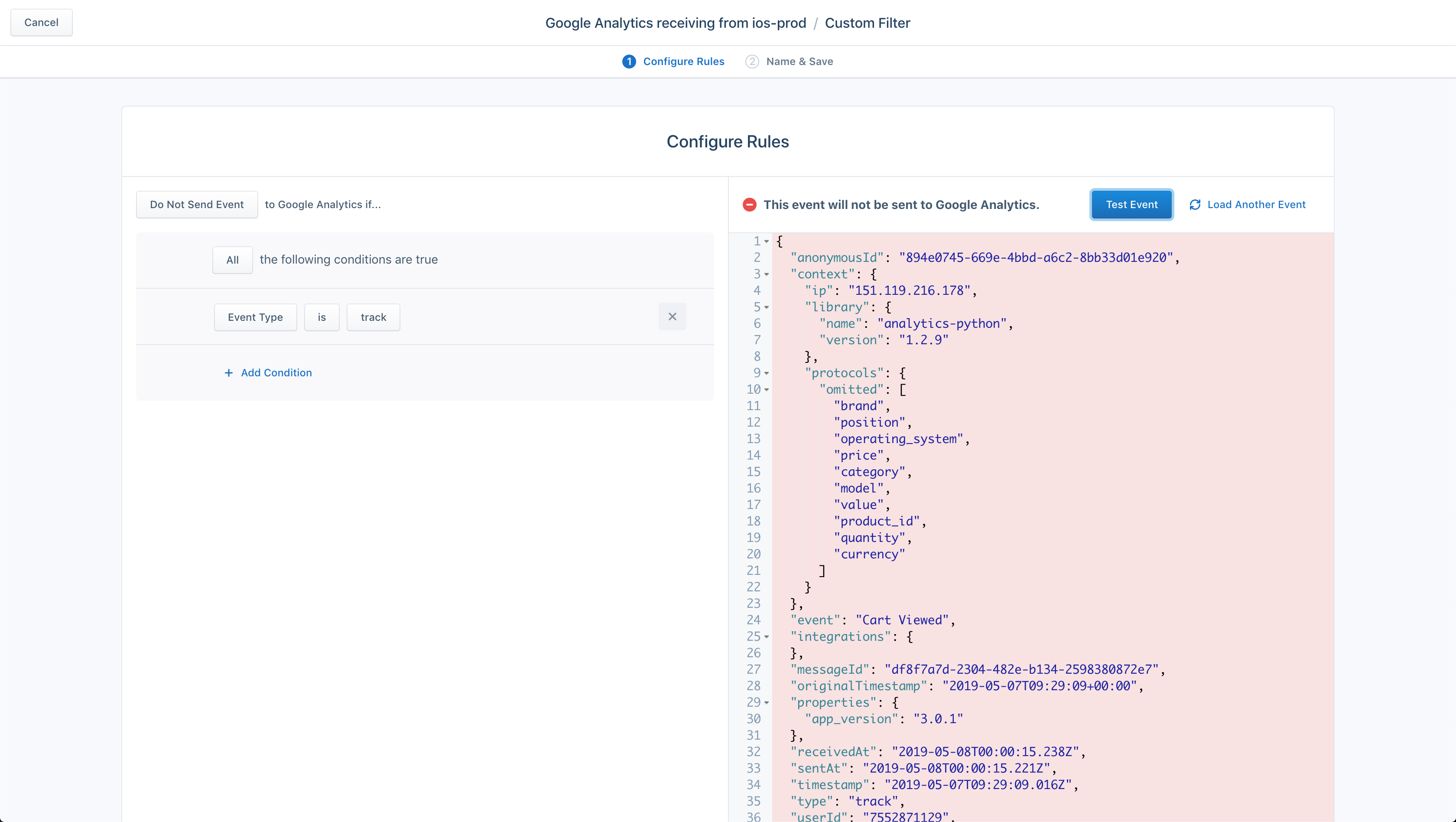
Remove Internal and Test Events From Production Tools
This rule targets email addresses with internal domains to stop test events from reaching Destinations.
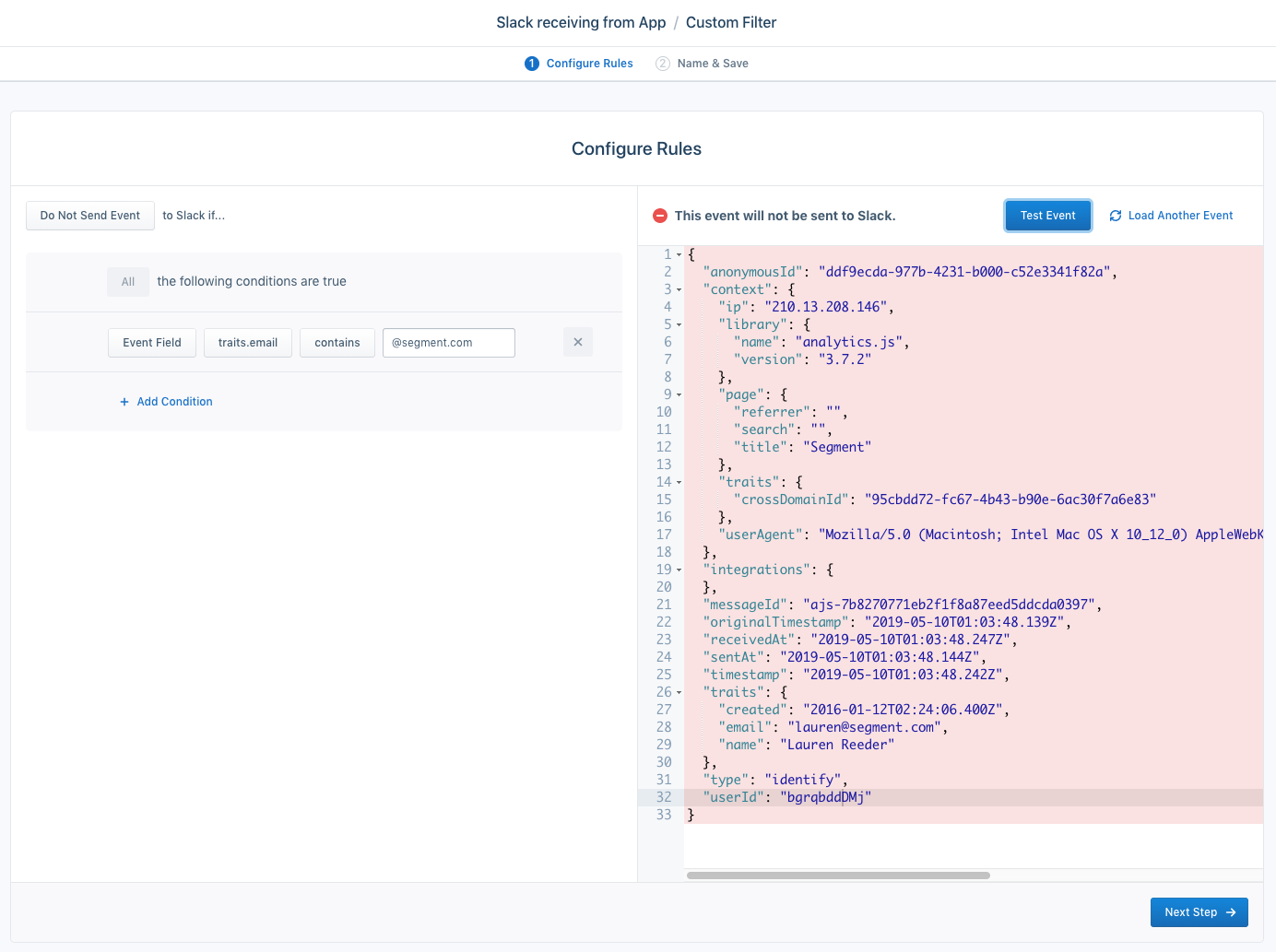
This rule prevents an event from sending if Order Completed and properties.email contain an internal @segment.com email address.
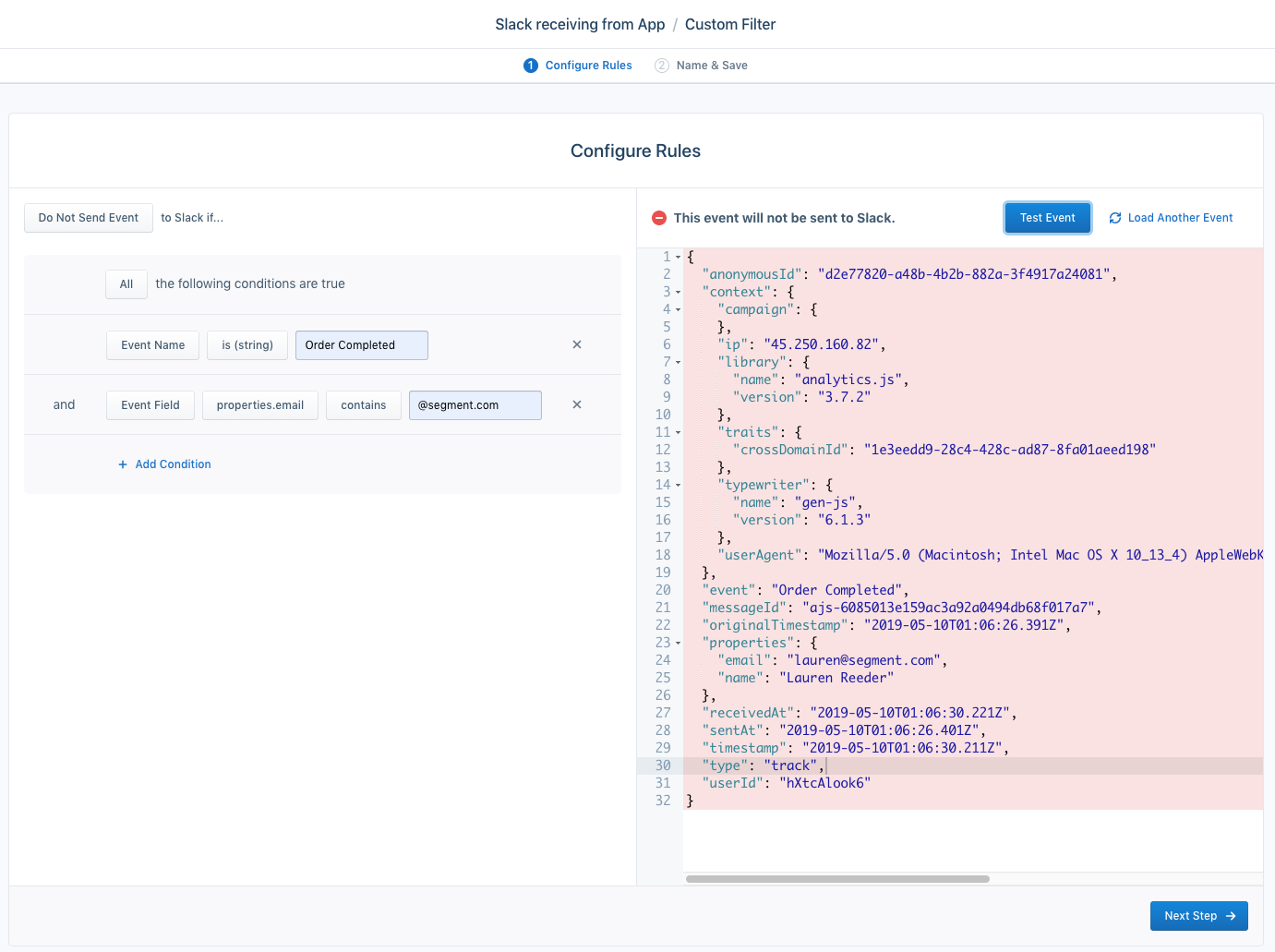
Sample a Percentage of Events
Using the Destination Filters API, you can create a rule to randomly sample video heartbeat events.
Drop Events
Watch this Destination Filters walkthrough to learn how to use event names to filter events sent to destinations.
Important Notes
Conflicting settings
Some destinations offer settings that also allow you to filter data. For example, the Facebook App Events destination allows you to map Screen events to Track events. Because Destination Filters are evaluated and applied before the Destination settings are applied, they can conflict with your settings.
In the example in the video above, if you have a Destination Filter that filters Track events and you have the Use Screen Events as Track Events setting enabled, Track events will be dropped, but Screen events still process. The destination settings will transform it into a Track event - after the filters.
Error handling
Segment makes effort to ensure that destination filters handle unexpected situations. For example, if you use the contains() FQL function on null field, Segment returns false instead of returning an error. If Segment can’t infer your intent, Segment logs an internal error and drops the event. Segment defaults to this behavior to prevent sensitive information, like a PII filter, from getting through.
Errors aren’t exposed in your Destination’s Event Deliverability tab. For help diagnosing missing destination filter events, contact Segment.
FAQ
How do Destination Filters work with array properties?
Destination filters can filter properties out of objects nested in an array. For example, you can filter out the price property of every object in an array at properties.products. You can also filter out an entire array from the payload. However, you can’t drop nested objects in an array or filter properties out of a single object in an array.
To block a specific property from all of the objects within a properties array, set the filter using the following the format: <propertyType>.<arrayName>.<arrayElementLabel>.
For example, the properties.products.newElement filter blocks all newElement property fields from each products object of an array within the properties object of a Track event.
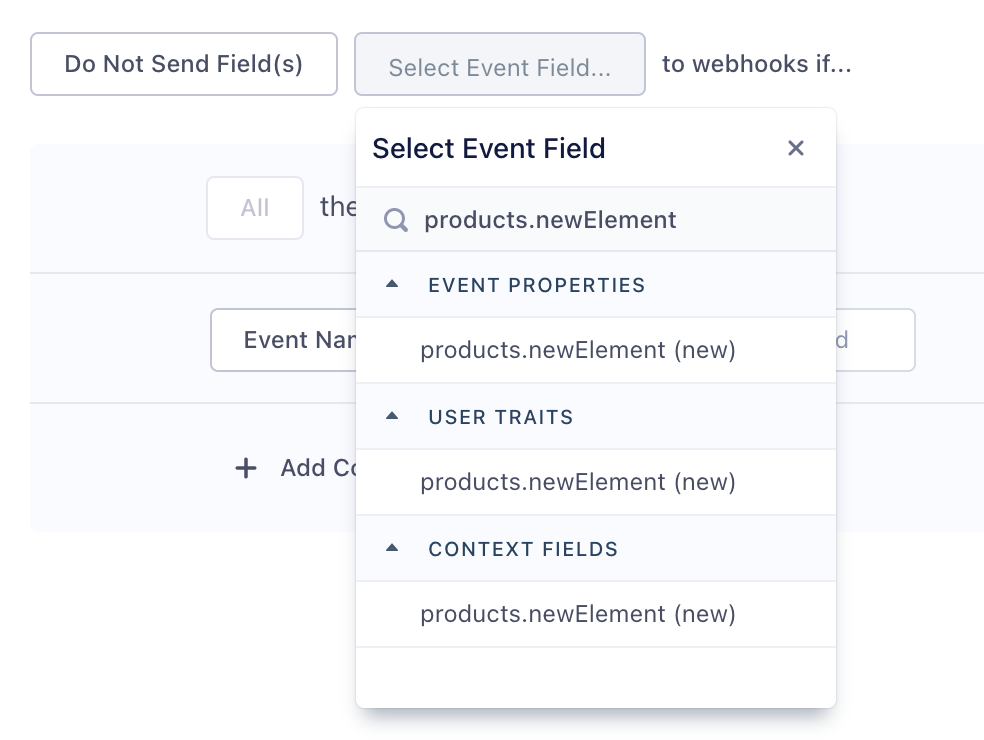
To block the Identify event trait products.newElement, select the option under the User Traits list instead. To block a context object field products.newElement, select it from the Context Fields list.
How many filters can I create?
Segment supports 10 filters per destination. If you need help consolidating filters or would like to discuss your use case, contact Segment.
How many properties can I view in the filter dropdown?
Segment displays the most recent 15,000 properties. To find a property not in the filter dropdown, enter the property manually.
How can I filter out warehouse events?
To filter out events from warehouses, use Selective Sync.
I don’t see a name property at the top level of my events to filter on “event name”.
Generally, only Track calls have “name” properties, which correspond to the “Event” field in an event.
How can I find out when new Destination Filters have been added or removed?
The activity feed shows the action, date, and user who performed the action when a Destination Filter is created, modified, enabled, disabled, or deleted. You can also subscribe to notifications for any of these changes in the Activity Feed settings page.
The Activity Feed shows the user, date, and action performed when a Destination Filter is created, modified, enabled, disabled, or deleted.
Why am I getting a permissions denied error when I try to save a filter?
You must have write access to save and edit filters; read permission allows viewing and testing access only.
How can I test my filter?
Use the Destination Filter tester during setup to verify that you’re filtering out the right events. Filtered events show up on the schema page but aren’t counted in event deliverability graphs.
This page was last modified: 25 Jan 2022
Need support?
Questions? Problems? Need more info? Contact Segment Support for assistance!